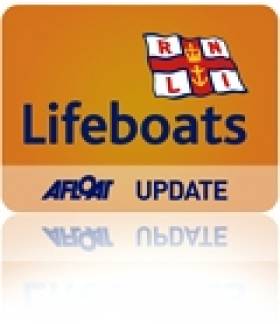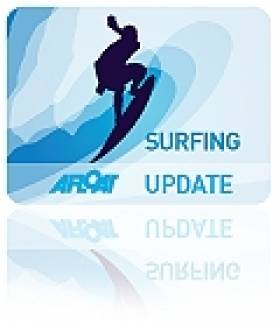Displaying items by tag: TV3
TV Premiere of ‘Islanders’ Airs Wednesday at 9pm on TV3
#islanderstv3 – Islanders is an emotional TV series following the lives of native islanders across an entire year. Filmed in 2014, this observational documentary is the biggest in-house production undertaken by 3Studios. From Arranmore, Co. Donegal via Inishturk in Co. Mayo to Whiddy in Co.Cork, this four part series captures a way-of-life rapidly disappearing.
As reported by Afloat back last month, the series is set within breath-taking landscapes, the islanders' stories are emotive, uplifting and told with honesty and frankness. Narrated by Irish actor Andrew Bennett ('Angela's Ashes', 'Garage', 'The Stag'), this is a landmark series for TV3, supported by the BAI.
Episode 1 begins 14 kilometres out from the Mayo coast, where the beautiful island of Inishturk reveals itself. With just 55 residents, it is home to Bríd Heanue (33) and her son Nathan (12). Bríd's eldest son Chris (16) lives and schools on the mainland.
With no secondary school on Inishturk Nathan will be leaving the island in September to join his brother at Rice College in Westport. It is a day Bríd dreads.
"In September, Nathan is leaving to go to school. That's a very emotional subject with me. It's going to be heart-breaking for me as he's been my little baby here at home. I'm going to find that very hard. All of our family are going to find that hard."
Nathan's leaving in September is going to affect the whole family – his mother will be losing her son, whilst the island will be losing another islander.
The series premiere also brings us down the coast to County Cork and in Bantry Bay, Whiddy island is the home place of twenty-two people. Here we meet two contrasting brothers: fisherman Danny O'Leary (51) and his brother Tim O'Leary (44), who is the islands publican, ferryman and post-man.
Last year the brothers got a rude awakening when they travelled to Inis Oirr on the Aran Islands for the first time. They were taken aback that other islanders had never heard of Whiddy. The few that had heard of Whiddy didn't think there were people living and working on it. The brothers were shocked and when they returned home they vowed to put their island and community back on the map.
Northwards, in the Donegal Gaeltacht, sits the stunning island of Arranmore. Just three kilometres from the coast, Arranmore has two car ferries, two co-operatives, a fire-service, a secondary school and even a nightclub! Outwardly it seems perfect but it has a problem, a problem emblematic of many islands – its population is in swift decline.
Dr Shirley Gallagher (early 40s) is a typical Arranmore Islander, born off the island in London whilst her island parents were working there, the family were reared on Arranmore. Shirley is well-travelled, well-educated and well able to speak her mind. Working in Sustainability & Environmental issues, Shirley returned home two years ago to apply all her learning and experience to her own home. She believes there are those on the island that don't want to see change whilst others are apathetic:
"When I saw the statistics on population decline I was truly shocked. You see the empty houses and derelict homes all around the place but it didn't really trigger. I thought I need to do something about this – and here I am."
Also a resident of Arranmore is mild-mannered fisherman Neilie Kavanagh (mid 40s). Although preparing for the busy season ahead, Neilie is heartbroken over the decline of the inshore fishing industry in Arranmore. The 'injustice' of what has happened to his fishing village is deeply felt and it is hard not to feel sympathy for him. He explains the Catch-22 of the 'harsh regulations'. If he is caught fishing illegally his licence will be revoked and his father's family boat will no longer be able to fish. He is the custodian of the boat – the St. Anthony, built by his father on Arranmore over 40 years ago. Neilie has never worked or lived off Arranmore.
With many twists and turns along the way, Islanders will follow the lives and stories of these characters over a tumultuous year, to learn what threatens their survival, to discover a different way of life, and to share in what it means to be an islander.
The series premiere of 'Islanders' airs this Wednesday at 9pm on TV3.
TV Documentary Series 'Islanders' Premieres in April
#islandlife – Coming to TV3 in April, Islanders is an emotional series following the lives of native islanders across an entire year. Filmed in 2014, this observational documentary is the biggest in-house production undertaken by TV3 Productions.
From Arranmore, Co. Donegal via Inishturk in Co. Mayo to Whiddy in Co.Cork, this four part series captures a way-of-life rapidly disappearing.
Set within breath-taking landscapes, the islanders' stories are emotive, uplifting and told with honesty and frankness. Narrated by Irish actor Andrew Bennett ('Angela's Ashes', 'Garage', 'The Stag'), this is a landmark series for TV3 Productions and the BAI.
Islanders features stories including two brothers' solemn promise to revive their island; a tug of loyalty between a mother's children and her island; a long-distance love story set 14 kilometres out to sea; a lone fisherman fighting bureaucracy to save his islands future and an embattled activist trying to galvanise her community.
Episode 1 begins 14 kilometres out from the Mayo coast, where the beautiful island of Inishturk reveals itself. With just 55 residents, it is home to Bríd Heanue (33) and her son Nathan (12). Bríd's eldest son Chris (15) lives and schools on the mainland.
With no secondary school on Inishturk Nathan will be leaving the island in September to join his brother at Rice College in Westport. It is a day Bríd dreads.
"I have two boys, Nathan and Chris. They are my world the two of them. We are a little pack the three of us. They adore Inishturk, it's their little piece of paradise.
"In September, Nathan is leaving to go to school. That's a very emotional subject with me. It's going to be heart-breaking for me as he's been my little baby here at home. I'm going to find that very hard. All of our family are going to find that hard."
The series premiere also brings us down the coast to County Cork where we meet two contrasting brothers on Whiddy Island: fisherman Danny O'Leary (51) and his brother Tim O'Leary (43).
In Donegal, we meet Dr Shirley Gallagher (40s) – a typical Arranmore Islander, born off the island in London whilst her island parents were working there, the family were reared on Arranmore. Shirley is well-travelled, well-educated and well able to speak her mind.
Also a resident of Arranmore is mild-mannered fisherman Neilie Kavanagh (40s). Although preparing for the busy season ahead, Neilie is heartbroken over the decline of the inshore fishing industry in Arranmore. He is the custodian of his father's boat – the St. Anthony, built by his father on Arranmore over 40 years ago. Neilie has never worked or lived off Arranmore.
With many twists and turns along the way, Islanders will follow the lives and stories of these characters to learn what threatens their survival, to discover a different way of life, and to share in what it means to be an islander.
TV3 Christmas Special to Feature 'Unsung Heroes' of Arklow RNLI
#RNLI - Volunteers from Arklow RNLI in Co Wicklow are to feature in a Christmas special to be broadcast on TV3.
The documentary, Unsung Heroes, will highlight the efforts of those who provide the essential rescue service throughout the year, including over the festive season.
It will be broadcast twice over Christmas, first at 8pm on Friday 21 December and again at 8pm on Sunday 23 December.
A TV3 film crew spent the morning of Tuesday 27 November at Arklow RNLI filming at what is the oldest of the 44 lifeboat stations in Ireland.
Producer Patrick Kinsella and cameraman Vinnie Broderick shadowed the volunteers on a training-based exercise when they launched their all-weather Trent class lifeboat, the Ger Tiighcelarr.
"The documentary is about unsung heroes," said Kinsella, "and I suppose given my own experience having worked in the shipping industry, I feel the RNLI and its people – the men and women who run and manage this organisation - cannot be praised enough for putting their lives at risk to save others, and I think this programme is a good way to shine a light on the work they do."
During the exercise, Kinsella and Broderick had the opportunity to experience first-hand and get a glimpse of the level of training required by RNLI volunteers to become highly skilled and efficient in order to carry out lifesaving work which can often be difficult and sometimes dangerous.
Interviews were carried out with lifeboat operations manager Jimmy Tyrell, coxswain Ned Dillon and volunteer crew member Stephen Furlong. Tyrell said filming with TV3 was a great opportunity to showcase the commitment of volunteers, not only in Arklow but in the many other coastal and inland water communities across Ireland.
He said the RNLI wouldn’t exist without fundraising, adding that the charity was totally reliant on the generosity of the public and indebted to work of fundraisers at station branches as well as those raising money inland.
Tyrell also said crew members would happily exchange their Christmas dinner and the comfort of their homes should the need arise this year to help anyone who may find themselves in difficulty at sea.
"It is because of the willingness and selfless nature of our volunteers, who will readily swap leisure, comfort and sleep for cold, wet and fatigue that the charity can provide an on-call, 24-hour lifeboat search and rescue service here," he said. "The RNLI depends on its volunteers who give their time, skill and commitment, even at Christmas time.
"Indeed, while our lifeboats are busy all year round, some of the most challenging callouts can occur over the winter months. And while most of us will be enjoying the Christmas festivities with our loved ones, we know that somewhere, RNLI lifeboats will be launched to help save lives at sea."
Surfers Sought for TV3 Dating Show
A TV producer is seeking surfers to take part in the next series of TV3's hit dating programme Take Me Out.
Sideline Productions is looking for both male and female "fun loving" contestants to audition for the enertainment show, where Today FM's Ray Foley plays cupid to thirty lovely ladies all hoping to find their perfect man.
This time around, the men of Ireland's surfing community are being encouraged to give it a shot.
Sideline wants singles who feel they have "the style and the personality to wow a TV3 primetime audience".
Application forms are available from www.tv3.ie/takemeout. The closing date for submissions is 31 October.
































































